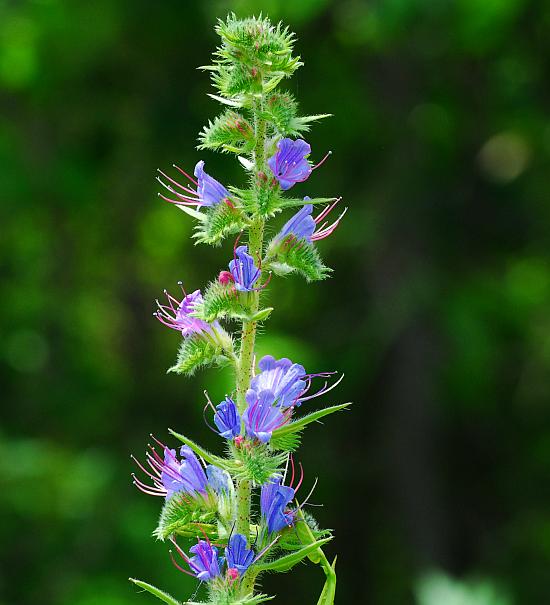Echium vulgare L.
Blueweed, Viper's Bugloss

Introduced
CC = *
CW = 5
MOC = 17
© SRTurner
Echium vulgare L.Blueweed, Viper's Bugloss | |
 |
Introduced CC = * CW = 5 MOC = 17 |
© SRTurner |
|
Family - Boraginaceae Habit - Taprooted biennial forb. Stems - Erect, to 80 cm, solitary or occasionally few, usually unbranched below the inflorescence, densely pubescent with minute, usually downward-pointed hairs and scattered to dense, longer, stiff, strongly pustular-based hairs, green with purple spotting (from pustular bases).
Leaves - Basal and alternate, sessile. Basal leaves sometimes withered at flowering and with the blades tapered at the base to a short or long petiole, the stem leaves mostly sessile and progressively reduced toward the stem tip. Leaf blades 2-25 cm long, 5-30 mm wide, those of the basal and lower stem leaves oblanceolate, those of the median and upper leaves narrowly oblong to narrowly lanceolate, tapered to angled or rounded at the base, mostly angled or short-tapered to a sharply pointed tip, the surfaces and margins moderately to densely pubescent with stiff, bristly, spreading to somewhat ascending, pustular-based hairs. Stem leaves short-petiolate to sessile, the blade 1-7 cm long, 2-8 mm wide, linear to narrowly lanceolate, angled or tapered at the base, without noticeable lateral veins, otherwise similar to those of the basal leaves.
Inflorescence - A panicle of numerous short, helicoid cymes, the branch points with leaflike bracts 1-6 cm long, the flowers with short, leaflike bracts, sessile or nearly so. Bracts and axis of inflorescence pubescent and with stiff hairs.
Flowers - Calyces more or less actinomorphic, 5-lobed nearly to the base, the lobes 5-7 mm long at flowering, sometimes becoming elongated to 6-10 mm at fruiting, narrowly triangular, bristly-hairy, persistent and ascending at fruiting. Corollas 12-20 mm long, more or less funnelform, zygomorphic, the upper 2 lobes longer than the other 3, bright blue (pink in bud), the tube 8-12 mm long, the throat lacking scales, the lobes 2-5 mm long, more or less ascending, rounded to bluntly pointed, hairy on the outer surface. Stamens attached at different levels below the midpoint of the corolla tube, the filaments elongate (1 shorter than the others), the anthers oblong to somewhat heart-shaped, long-exserted from the corolla. Ovary deeply 4-lobed, the style long-exserted from the corolla, finely hairy, usually withered at fruiting, the stigma capitate, strongly 2-lobed. Cleistogamous flowers not produced.
Fruits - Schizocarps dividing into mostly 4 nutlets, these 2.0-2.8 mm long, erect to slightly oblique, angular-ovoid with a relatively sharp ventral keel, attached to the relatively flat gynobase at the base or nearly so, the attachment scar surrounded by a collarlike ring, bluntly pointed at the slightly oblique tip, the surface strongly longitudinally wrinkled and warty or tuberculate, dark brown to nearly black with tan to white raised areas. Flowering - May - September. Habitat - Streambanks, upland prairies, forest openings, pastures, gravel bars, railroads, roadsides, open disturbed areas. Origin - Native to Europe. Lookalikes - None. Other info. - This striking species is best viewed and not handled. The sharp, spiny hairs, which cover the plant, are a powerful deterrent and can become lodged in the skin much like those of a cactus. In Missouri this species is mainly found toward the southeastern region of the state, and appears to have expanded its range only slightly since the time of Steyermark's 1963 publication. It is found commonly in the northeastern U.S., with more scattered populations in other parts of the country. Photographs taken off Highway 106 in Ellington, MO., 6-8-01, and off Hwy 40, Iron County, MO., 6-1-03 (DETenaglia); also at Johnson's Shut-Ins State Park, Reynolds County, MO, 6-20-2011 and 10-1-2018, near Pea Ridge Mine, Washington County, MO, 6-8-2013, near the Bee Fork River near Reynolds, Reynolds County, MO, 6-20-2022, and near Eminence, Shannon County, MO, 5-19-2023 (SRTurner). |